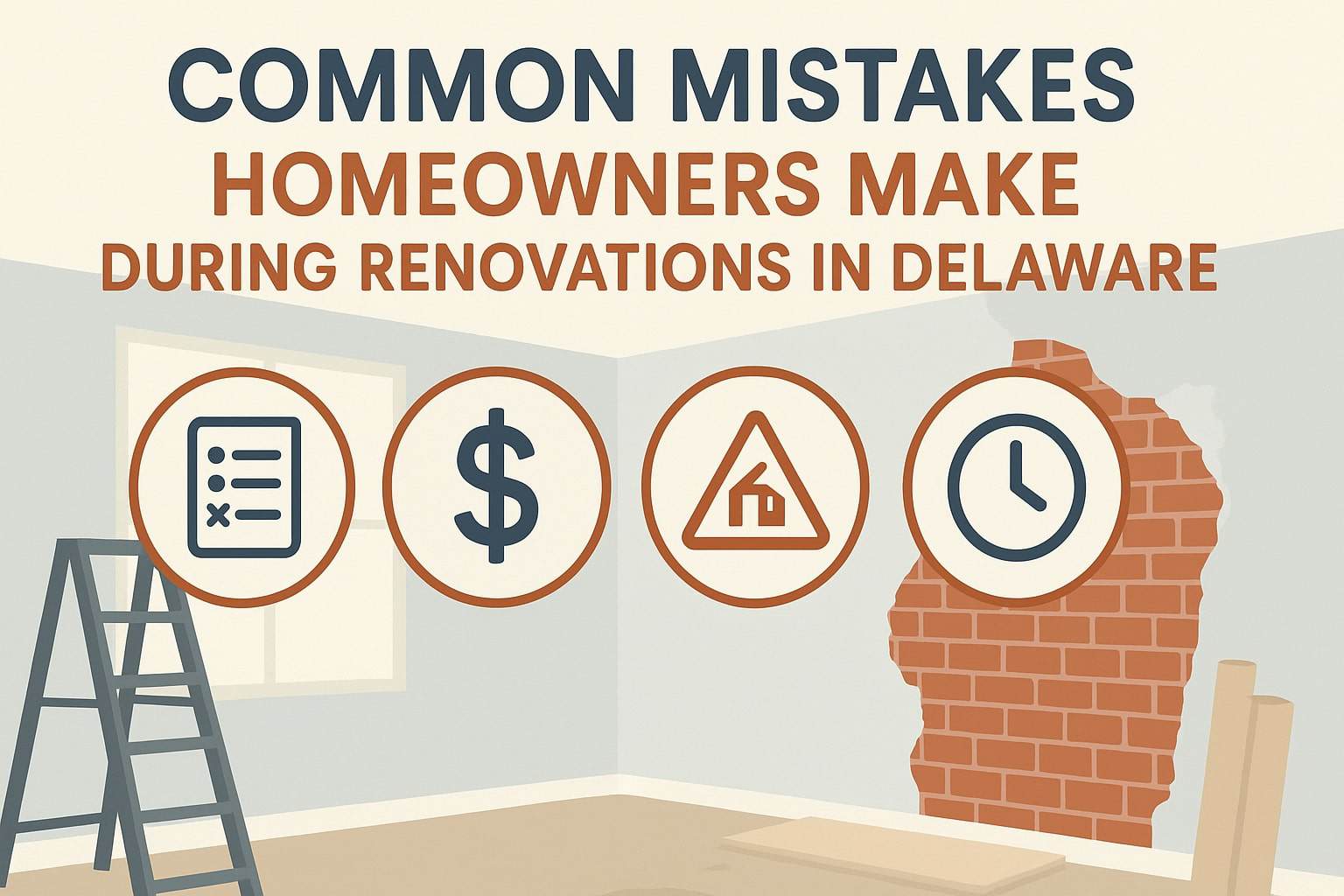
By 302renovations November 3, 2025
Renovating a home in Delaware can boost comfort, property value, and long-term livability, but home renovation mistakes can quickly turn a dream project into stress and expense. Delaware has unique permitting, coastal, and seasonal factors that shape every project’s risk profile.
Homeowners in New Castle, Kent, and Sussex counties also face different timelines, inspection practices, and neighborhood covenants. The most common errors start early: unclear scopes, weak contracts, and budgets that ignore contingency and soft costs.
They continue with contractor selection shortfalls, energy-inefficient choices, and ignoring floodplain, wind, and humidity realities. The good news is that every mistake on this list is avoidable with a little planning, the right language in your contract, and a realistic schedule that accounts for permitting, lead times, and inspections.
This guide breaks down the biggest home renovation mistakes in Delaware, explains why they happen, and shows exactly how to sidestep them. You’ll learn how to verify licensing and insurance, build a resilient budget, use detailed scopes of work, plan sequencing to avoid rework, and factor in local codes, energy incentives, and coastal conditions.
The sections are practical and easy to scan, with plain language checklists and region-specific tips. By the end, you’ll have a renovation playbook that fits Delaware’s rules, climate, and market—so your project finishes on time, on budget, and with fewer headaches.
Mistake #1: Skipping Permits and Code Compliance in Delaware

One of the most expensive home renovation mistakes is starting work without the right permits. In Delaware, permitting isn’t one-size-fits-all. Your jurisdiction may be a county (New Castle, Kent, Sussex) or a municipality (like Wilmington, Newark, Dover, Rehoboth Beach).
Each authority has its own intake forms, plan review timelines, and inspection sequences. Even “small” projects—decks, structural changes, egress windows, load-bearing wall removals, electrical service upgrades, and plumbing relocations—usually require a permit.
Skipping permits risks stop-work orders, fines, forced tear-outs, and trouble at resale when buyers’ inspectors or appraisers spot unpermitted work.
Code compliance goes beyond the permit card. Delaware homes face coastal wind loads, floodplain elevations, and humidity that demand proper flashing, WRB integration, and ventilation.
Electrical work must meet NEC, while structural changes must follow engineer-stamped drawings when required. Many towns also enforce design review or HOA guidelines for exterior changes. Permits protect you: inspectors verify safety, contractors stay accountable, and your renovation builds documented value.
The fix is simple: ask your contractor to handle permitting, keep permit numbers on your contract, and schedule inspections into the project calendar. When in doubt, call your local building department before demo day.
County-by-County Nuances You Can’t Ignore
New Castle County typically has more urban and suburban job sites, with added attention to zoning and setbacks. Expect plan checks for egress, fire blocking, and structural changes. Kent County projects often involve aging housing stock, where electrical and plumbing must be brought up to current standard when walls are opened.
Sussex County brings coastal and wind-borne debris zones into the picture, plus floodplain management in beach towns and along inland bays. Municipalities within each county can add their own wrinkles, like architectural review districts or historic overlays.
A strong pre-construction routine prevents home renovation mistakes across all three counties. Start with a two-page permitting map: list your authority having jurisdiction (AHJ), submittal method (online vs. in-person), required drawings, expected fees, and target inspection milestones.
Build a permit plan into your Gantt chart so trades don’t mobilize before approvals land. Keep copies of stamped plans on site, and post your permit card where inspectors can see it. Finally, verify close-out steps—final inspection, certificate of completion, and any floodplain elevation documentation—so you don’t hit surprises when it’s time to refinance or sell.
Mistake #2: Underestimating Total Project Cost

Another classic home renovation mistake is budgeting only for visible materials and labor. True project cost includes design fees, engineering, permit fees, dumpster service, site protection, temporary facilities, inspections, utility upgrades, and change order risk.
In Delaware, add seasonal pricing volatility for lumber and roofing, coastal corrosion-resistant fasteners, and potential flood-resistant assemblies. Appliance and window lead times can drive storage costs or rescheduling fees when deliveries don’t align with readiness.
To avoid cost shock, create a layered budget: base bid, allowances with realistic ranges, and a contingency of 10–20% depending on project complexity and the age of your home. For older homes in Wilmington, Dover, or coastal towns, plan higher contingencies for hidden structural repairs, knob-and-tube electrical, cast-iron drain replacement, or moisture mitigation.
Price out alternates for items most likely to blow the budget—tile, countertops, millwork—and decide in advance which swaps you’ll make if bids come in high. A transparent cost plan turns home renovation mistakes in Delaware into manageable choices, not emergencies.
Hidden Costs Delaware Homeowners Overlook
Beyond the obvious, Delaware projects often encounter soft costs: surveys to confirm setbacks, coastal zone considerations, lead-safe practices, and site dehumidification in humid months. Insurance riders may be required, and you might pay for off-site storage of furnishings.
If you’re renovating a beach property, factor HOA architectural review fees and stricter exterior specs. In flood-prone areas, raising mechanicals or installing flood vents adds cost but protects long-term value. Plan for landscaping repair after heavy equipment use, driveway resealing if dumpsters or lifts mar the surface, and post-construction cleaning.
Don’t forget operational costs during construction. Short-term housing or phased living can impact your budget. Portable bathrooms, temporary kitchen setups, or pet boarding are easy to miss. Finally, calculate the cost of delays.
If an inspection gets pushed or a special-order window arrives late, your schedule buffer—and wallet—takes the hit. Building these into your pro former prevents home renovation mistakes that derail cash flow and morale.
Mistake #3: Hiring the Wrong Contractor

Choosing on price alone is a high-risk home renovation mistake. Delaware’s contractor market ranges from one-truck outfits to full-service design-build firms. What matters is fit: licensing, insurance, experience with your project type, and capacity to manage permits, inspections, and subs. Verify a contractor’s portfolio in your county, not just in general.
Ask for three recent references and one from an older project to gauge durability. Confirm workers’ compensation and general liability coverage naming you as additional insured for the project term.
Process matters, too. A professional contractor offers a detailed scope of work, clear payment schedule tied to milestones, written change order procedures, and a realistic timeline. They communicate early about lead times, long-pole items, and inspection sequencing.
The right partner won’t push you to skip permits or pay cash to “save tax.” They’ll embrace checklists, daily logs, and punch-list software. This mindset reduces home renovation mistakes in Delaware and keeps everyone aligned from demo to final clean.
A Delaware-Specific Vetting Checklist
Start with license verification and local reputation in your jurisdiction. Ask if the contractor has passed inspections in your city or county in the past 12 months. Request proof of experience with coastal assemblies if you’re in Sussex, or row-home structural alterations if you’re in Wilmington.
Review a sample permit set they produced. Demand lien waivers from subs with each draw. Require a certificate of insurance with your address listed. Get a recent schedule from a similar project to see how they build buffers around inspections and special orders.
Interview for communication style. Will you get weekly updates with photos? Do they use project management tools? What is the escalation path if a decision stalls the schedule?
Finally, talk to suppliers. Ask your local lumberyard, tile shop, or window dealer whether the contractor pays on time and plans orders carefully. Suppliers often spot patterns that predict home renovation mistakes long before homeowners do.
Mistake #4: Vague Planning and Scope Creep
Scope creep—changes that balloon cost and duration—is a universal home renovation mistake. It strikes when the scope of work is fuzzy, selections are “TBD,” or drawings leave room for interpretation.
In Delaware, creep also happens when permit comments force mid-stream redesigns. Prevent it with a complete pre-construction package: dimensioned plans, elevations, product schedules, finish schedules, and installation details.
Align every allowance with a specific showroom, price tier, and cut sheet. The more decisions you finalize before the demo, the smoother your project will run.
Use a change-order log that shows cost, schedule impact, and who requested the change. Cap discretionary changes after a certain milestone, and make exceptions only for code or concealed conditions.
Lock critical path items—windows, doors, cabinets—early to avoid re-framing or delay. Share your “no compromise” list with your contractor and delegate all other micro-decisions. This disciplined approach keeps home renovation mistakes in Delaware from snowballing once walls come down.
Smart Sequencing and Documentation
Great sequencing prevents rework. Install air sealing and rough-ins before insulation, then confirm inspection approvals prior to drywall. Order long-lead items during design, not after demo. Get all shop drawings and submittals approved before fabrication.
Keep an updated set of drawings on site, including any revisions required by plan review. Use photo documentation of framing, wiring, and plumbing before walls close; those images will save hours later.
Document acceptance criteria: grout joint sizes, paint sheen, cabinet reveals, and wood floor moisture thresholds. When quality standards are explicit, punch lists shrink.
Combine that with weekly owner-contractor meetings, and you’ll catch drift while it’s still easy to fix. Good documentation transforms potential home renovation mistakes into data-driven decisions.
Mistake #5: Ignoring Energy Efficiency, Moisture, and Resilience
In Delaware, humidity, wind, and coastal weather create a unique performance profile. Choosing the cheapest insulation, skipping continuous air sealing, or ignoring balanced ventilation are costly home renovation mistakes.
Comfort and durability depend on controlling water, air, and heat. Prioritize a continuous weather-resistive barrier, proper flashing at penetrations and windows, and smart vapor control. Upgrade attic insulation, rim joist sealing, and duct sealing, which often deliver quick payback.
Resilience matters, especially in Sussex County and along waterways. Consider impact-rated openings where appropriate, corrosion-resistant fasteners, flood-resistant materials at lower levels, and elevating mechanicals.
Energy-efficient windows, heat-pump HVAC, and heat-pump water heaters reduce operating costs and improve indoor air quality. Pair with ERVs/HRVs to manage humidity. Together, these choices prevent home renovation mistakes in Delaware that show up as mold, peeling finishes, or high utility bills.
Local Incentives and Floodplain Realities
Look for utility rebates on high-efficiency HVAC, smart thermostats, and weatherization. Incentives can offset incremental costs of better windows, insulation, or heat-pump equipment. In floodplains, consult your local floodplain administrator early.
You may need elevation certificates, flood vents, or limitations on below-base-flood renovations. Materials like closed-cell spray foam, fiber-cement, and tile at lower levels recover better after wetting.
Finally, specify continuous bath fan ventilation on timers, proper kitchen exhaust to the exterior, and whole-house dehumidification if needed. Good design plus incentives makes resilience affordable—and keeps home renovation mistakes from eroding your investment over Delaware’s hot summers and storm seasons.
Mistake #6: Underestimating Timeline, Seasonality, and Logistics
Schedules fail when homeowners assume straight-line timelines. In Delaware, seasonality adds complexity. Summer means beach-area traffic and booked trades; winter brings shorter workdays and weather delays.
Holidays slow inspections and supplier response. Lead times for windows, doors, and custom cabinets can stretch eight to sixteen weeks, and that clock often starts upon shop drawing approval, not deposit. Building a realistic timeline is the antidote to home renovation mistakes that drag on for months beyond plan.
Map critical path items, bake inspection windows into the calendar, and hold floats for re-inspection or backordered components. If you’re renovating a beach property, account for tenant or short-term rental schedules and HOA rules on work hours.
In cities like Wilmington or Newark, plan for parking permits, dumpster placement, and elevator reservations in multifamily buildings. Good logistics planning keeps your home renovation mistakes in Delaware from becoming schedule crises.
Planning Around Storms, Events, and Access
For exterior work, track storm forecasts and wind advisories; reschedule roofing or window installations that depend on dry conditions. For interior work, plan material acclimation—flooring and millwork tolerate Delaware humidity better when properly staged.
Sequence deliveries to avoid storing moisture-sensitive products in garages during muggy months. If your neighborhood hosts events or parades, coordinate around street closures to keep dumpsters serviced and deliveries moving.
Access is a hidden schedule killer. Narrow lots or shared driveways can limit crane or lift access for heavy units. If you need a temporary power upgrade, submit early. Align utility shutoffs with inspections to avoid repeat mobilizations.
These small planning steps prevent home renovation mistakes that otherwise show up as idle crews and lost days.
Mistake #7: Cutting Corners on Materials and Safety
Selecting bargain materials for critical assemblies—roofing, windows, WRB, fasteners—is a frequent home renovation mistake. Delaware’s humidity and coastal air punish cheap components.
Use stainless or hot-dipped galvanized fasteners where exposure or salt air threatens longevity. Pick WRB systems compatible with your cladding and flashing approach. Cheap paint fails fast in coastal UV; better coatings last longer and reduce maintenance.
Safety shortcuts cost more. Protect floors, stair treads, and HVAC returns during construction to avoid damage and dust contamination. Require dust control, negative-air setups during heavy demo, and HEPA filtration when sanding or cutting indoors.
Proper PPE and site cleanliness prevent injuries and project stops. Intelligent material choices paired with solid safety plans keep home renovation mistakes in Delaware from snowballing into warranty claims and health complaints.
Lead Paint, Asbestos, and Older Delaware Homes
Many Wilmington and Dover neighborhoods include pre-1978 housing stock, making lead paint a real concern. Renovation, repair, and painting work must follow lead-safe practices to protect your family and meet federal and local rules.
Older homes may also hide asbestos in floor tiles, mastics, pipe wrap, or siding. Testing before demo avoids dangerous exposures and price change orders mid-stream.
If hazards are confirmed, hire certified abatement pros and plan extra time for containment and clearance. Update electrical and plumbing while walls are open to avoid future tear-outs. These steps aren’t just compliance; they’re risk management that saves money and prevents severe home renovation mistakes downstream.
Mistake #8: Weak Contracts, Insurance Gaps, and Payment Risks
Handshake deals are an invitation to home renovation mistakes. Your contract should include a complete scope of work, detailed drawings, start and completion windows, a milestone-based payment schedule, named permit responsibility, submittal requirements, and a defined change-order process.
Require daily site protection standards, cleanup expectations, and a punch-list procedure with deadlines. Make sure warranty terms are written, with who handles product vs. labor coverage.
Insurance is non-negotiable. Confirm general liability, workers’ comp, and, for larger jobs, builder’s risk coverage. Ask for certificates with your address as the project location. Use conditional lien waivers from subs and suppliers with each draw to protect against liens if a prime contractor fails to pay.
In Delaware, add your HOA’s or lender’s specific requirements to the contract exhibits. Solid paperwork prevents home renovation mistakes in Delaware that end in disputes.
Payment Schedules, Retainage, and Closeout
Tie payments to measurable milestones: demo complete and inspected, rough-ins approved, drywall finished, trim installed, substantial completion, and final inspection. Keep a modest retainage (often 5–10%) until punch-list items are fully resolved.
Require a closeout package with warranties, manuals, as-builts, and final lien releases. Document substantial completion with dated photos and sign-offs.
If financing through a renovation loan, align contractor draws to lender inspections and submission windows. For cash projects, avoid large upfront deposits for labor; deposits should track true procurement needs. Clear money rules stop home renovation mistakes from turning into legal problems.
Mistake #9: Overlooking Accessibility, Aging-in-Place, and Future-Proofing
Ignoring accessibility is a missed opportunity and a common home renovation mistake. Delaware households often host multigenerational families and coastal guests. Designing for universal access increases livability and resale value.
Think curbless showers, wider doorways, lever handles, blocking for future grab bars, better lighting, and non-slip flooring. Plan clear pathways from parking to entries, and consider at least one no-step entrance.
Future-proofing also means flexible spaces and smart infrastructure. Run conduit for EV charging, pre-wire for solar or battery storage, and add dedicated circuits for future equipment.
Choose layouts that adapt to home offices, hobbies, or short-term rentals where allowed. These upgrades cost little during renovation and prevent home renovation mistakes in Delaware where homes outgrow their systems within a few years.
Resale, Appraisals, and Neighborhood Context
Design in harmony with your block. Appraisers in Wilmington, Middletown, Dover, and Lewes weigh market comps and quality of finishes. Over-customization can cap appraisal value; under-building for the area can waste potential.
Maintain curb appeal consistent with neighborhood standards or HOA expectations. Thoughtful exterior upgrades—long-life roofing, classic window styles, and durable siding—help appraisals and reduce maintenance.
Document upgrades with receipts, permits, and energy improvements. Provide this packet to appraisers and future buyers. A transparent history showcases quality and avoids the home renovation mistakes that scare off buyers during due diligence.
Mistake #10: DIY Without the Right Skills, Tools, or Time
DIY can be rewarding, but misjudging complexity is a common home renovation mistake. Structural changes, service upgrades, gas lines, waterproofing, and envelope details demand pro-level skill.
Delaware inspectors expect work that meets code and manufacturer specifications; DIY shortcuts often fail these tests. Even “simple” tasks like tiling require substrate preparation, waterproofing membranes, and expansion joints you won’t see on a quick tutorial.
A balanced approach works best: handle demo, painting, or landscaping while pros manage critical path work. If you DIY, stage mockups, pull the proper permits, and book inspections.
Invest in the right tools, protect the site, and build slack into your schedule so life events don’t stall progress. Smart boundaries keep home renovation mistakes in Delaware from turning into costly do-overs.
When to Call a Pro in Delaware
Call pros for engineering-related framing changes, electrical service upgrades, HVAC design and load calculations, window and door reframing, and any work in wet areas that demands waterproofing systems.
Use licensed plumbers for supply and drain relocations, and certified roofers for warranties to remain valid. If your property sits in a flood zone or historic district, consult specialists familiar with local rules.
Bring in a design-build or architect when moving walls, changing exterior openings, or adding square footage. Their drawings speed permits, reduce RFI ping-pong, and clarify bids.
Delaware trades see the same issues every week; their experience pays for itself by avoiding home renovation mistakes you won’t spot until it’s too late.
FAQs
Q.1: Do I really need a permit for small projects in Delaware?
Answer: For many projects, yes. Decks, structural changes, new egress windows, electrical service upgrades, and plumbing relocations usually require permits across New Castle, Kent, and Sussex counties.
Some interior cosmetic work—like painting, floor replacement, or same-location fixture swaps—may be exempt, but always verify with your local building department.
Permits protect you by ensuring inspections, which catch safety issues before they become expensive failures. Unpermitted work risks fines, stop-work orders, and future sale complications when buyers request permit histories.
A smart approach is to discuss permitting during contractor selection. Require your contractor to list the permit type, expected timeline, and inspection schedule in the proposal. Budget for fees and plan review.
If you’re in a floodplain or coastal zone, assume extra documentation like elevation certificates or engineered connections. Treat permitting as a standard project phase, not a nuisance, and you’ll avoid one of the most common home renovation mistakes in Delaware.
Q.2: How much contingency should I set aside for a Delaware renovation?
Answer: Set aside at least 10% for newer homes and 15–20% for older or coastal properties. Delaware’s aging housing stock, humidity, and floodplain conditions add uncertainty behind walls and under floors.
Contingency covers concealed issues—rot, termite damage, outdated wiring—as well as code-driven upgrades once assemblies are opened. It also cushions schedule bumps from inspection delays or backorders.
Build contingency at two levels: a general reserve you control, and line-item allowances for selections prone to cost swings, like tile and stone. Track changes in a live spreadsheet, and make tradeoffs when overruns hit.
With this structure you’ll keep control, avoid panic purchases, and prevent budget-blowing home renovation mistakes that ripple through the rest of the project.
Q.3: What should be in a rock-solid Delaware renovation contract?
Answer: A strong contract lists a complete scope of work tied to drawings, a milestone-based payment schedule, who pulls permits, inspection requirements, and a change-order process.
It should include start and completion windows, site protection standards, daily cleanup, and punch-list procedures. Insurance requirements—general liability, workers’ compensation, and sometimes builder’s risk—must be explicit, with certificates naming your property.
Add exhibits for product schedules, finish schedules, and any HOA or floodplain conditions. Require lien waivers from subs and suppliers with each draw. Include warranty terms and closeout deliverables, like manuals and as-builts.
When your paperwork is this clear, disputes shrink and your chance of home renovation mistakes in Delaware drops dramatically.
Conclusion
Avoiding home renovation mistakes is about process, not luck. In Delaware, that process begins with permits and code alignment, continues with a realistic budget and schedule, and succeeds through contractor vetting, detailed scopes, and disciplined change management.
Layer in energy efficiency, moisture control, and coastal resilience to protect your investment for decades. Choose durable materials, respect safety, and plan for accessibility so the home serves every stage of life.
If you take one action today, build a pre-construction checklist: AHJ and permit path, drawings and selections, milestone schedule with inspection windows, insurance and lien waivers, and a contingency plan.
Share it with your contractor and hold weekly check-ins to keep the team aligned. With a clear roadmap, your Delaware home renovation can be smooth, efficient, and future-ready—delivering comfort, value, and peace of mind without the common pitfalls that trip up so many projects.